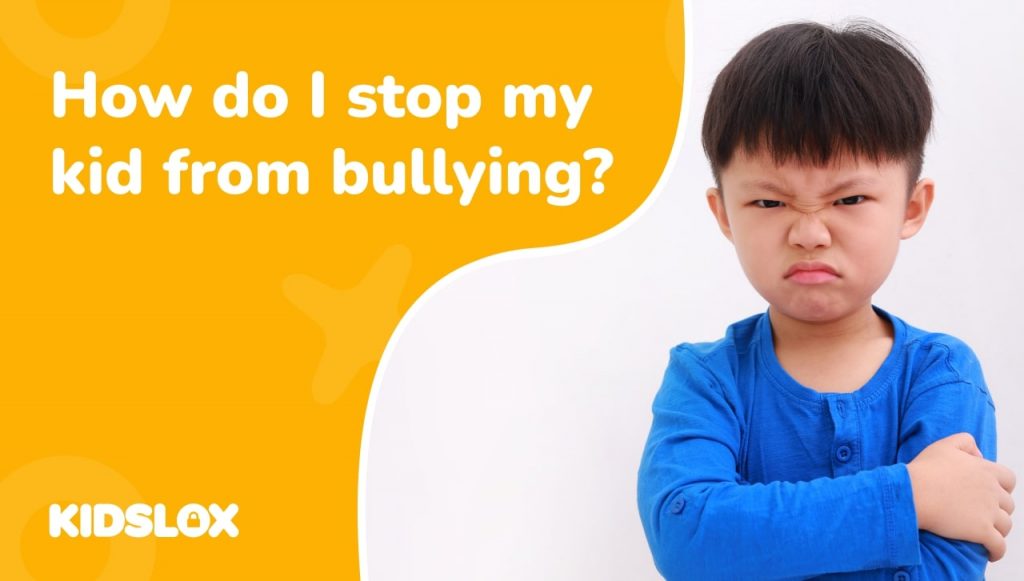It’s a difficult moment for any parent and family to deal with when the school calls home and tells you that your child has been accused of bullying someone. Feelings of guilt, shame, anger, and of course, disappointment, are not uncommon.
If you have been on the receiving end of this type of news, it can feel like a damning assessment of your parenting skills. How did this happen? And when did your little angel turn into the playground bully?
In this article, we take a look at some of the reasons why children bully others, how to spot if your child is being a bully, and how to get them to behave in a more socially positive way going forward.
Is my child a bully?
Let’s face it. Kids can be really mean. Especially when they’re little and haven’t learned the skills they need to emotionally regulate themselves to always be kind. Playground spats are not uncommon and when it comes to siblings, some households have to deal with all-out domestic wars.
But there is a fine line between harmless falling out and bickering and the repeated, aggressions that constitute bullying.
According to the US Government resource, Stop Bullying, the definition of bullying is unwanted, aggressive behavior that involves a real or perceived power imbalance. Within this definition, it is important to note that the behavior has been repeated or has the potential to be repeated.
Bullying tactics are diverse. Bullies may use physical differences, including strength, body weight, and height to bully their peers. While others can use more socially insidious tactics, including leveraging their popularity, as well as ‘insider knowledge’ on others to carry out more subtly aggressive bullying behaviors.
There are lots of ways to bully others, from rumor spreading, physical attacks, name-calling, and exclusion tactIcs. And, as our social lives shift online, these behaviors often take place on social media apps and through other digital platforms.
The National Bullying Prevention Centre claims that a fifth of children report being bullied in the school year. And one in five ‘tweens’ (9 to 12-year-olds), report that they have either been cyberbullied, witnessed it, or taken part in cyberbullying themselves.
It goes without saying that bullying is a top concern for parents and children, and schools should have a strong stance on stamping out, and preventing bullying from happening to students both on and offline.
You may have had a call from the school, or perhaps you’ve been confronted by another parent about the behavior of your child towards theirs. But sometimes it’s because you have a suspicion about their behavior at home, or towards their siblings that makes you worry and wonder if they’re bullying others too.
The signs to look out for include:
- Increasingly aggressive behavior at home – this includes shouting, name-calling, and hitting out
- More disciplinary meetings or detentions in school, or perhaps have you noticed poor grade performance that’s out of character?
- Hanging out with children who are known to bully others and showing more disobedient behavior than before
- Having items you weren’t aware of that may have been taken from others
- Being overly concerned about their reputation, social standing or deliberately asking to exclude people from parties or events
What causes a child to bully others?
You’ve had the call and now you’re asking yourself, ‘why is my kid a bully?’
The reasons why a child acts aggressively towards others are complex.
Experts agree that in a lot of instances, it is a way for a child to gain the power and control that has been taken from them in other areas of their life.
For example, a child with an older, aggressive sibling might replicate their bullying behavior in the classroom. Sadly, in many instances, children bully others because they have witnessed others displaying bullying behaviors at home.
Other reasons can include the facets of a child’s personality. Domineering and demanding children’s behaviors can often bleed into bullying if they get into the habit of engineering social situations to get their way.
When it comes to social hierarchies, children can often begin bullying behavior to bolster their self-esteem This can often manifest through social exclusion tactics, rumour spreading and cyberbullying.
How to approach your child if they have been bullying someone
If your child’s teacher or another parent has reported that your child has been bullying someone else you’re likely to feel disappointed and upset. Don’t rush in and discipline your child without giving them an opportunity to explain their behaviour first. The first thing to do is approach the issue with an open mind and give your child the space to communicate and tell their side of the story.
Try and unpick the reasons behind the bullying behavior
This isn’t going to be easy – especially if your child is young and emotionally immature. It’s hard for adults to understand where their aggression stems from, so asking a child complex questions about the motivations behind their behavior is unlikely to be successful.
Try to understand the different factors in the scenarios where your child is being a bully. So much of bullying behaviour boils down to low self-esteem and feeling threatened, either physically, or socially, and finding those motivations can help strategize how to prevent it in the future.
For example, if your child is a keen footballer and they’re worried that their spot on the team is under threat, they could take to namecalling and belittling a peer to boost their self-esteem and knock the confidence of their competitor.
How to prevent bullying behaviour in future
Once you’ve identified the instances that can trigger your child’s anti-social behavior, it’s time to strategize how you can help them face these situations more healthily.
Positive reinforcement tactics can be useful in these scenarios – instead of telling your child what NOT to do, guide them and help as to what you want them to do in instead in future.
For example, if your child has been excluding one particular person from a weekly gettogether, tell them that you expect them to be invited next time. Similarily, if your child has a habit of bullying by making mean comments about others, challenge them to say something nice to a friend every day and let them report back to you what they’ve said and done.
Let them know that you won’t tolerate unkind language and be clear about what the consequences will be if they use it. And always give praise for good behaviour.
Don’t call them a bully
Childhood bullying is very common and often stems from situational or emotional immaturity, not a deep-rooted personality issue. Labeling your child as the classroom bully can impact their self-esteem, which in turn can make behaviors worse. If someone tells you you are something, it’s not hard to see how your identity can be shaped around that, especially if they are told by someone they love and respect.
Discuss the situation as a friendship-based one and explain how important it is to be kind and respectful to everyone to maintain, grow and create new friendships with others.
Use age-appropriate examples of how their behavior might make another person feel, and how they might feel if it happened to them.
Ensure apologies are made
It’s an important skill to acknowledge when you are wrong and be able to make amends.
Once the facts have been established, your child has had the opportunity to tell their version of events, and the bullying behavior has been identified and acknowledged, it’s time for apologies.
This can be difficult for all children and so you can encourage them to do it in a means that feels most appropriate, be it in a letter or face to face.
Be clear on the consequences
Once you have established the cause, and the situations in which your child is a bully, now you can set some firm boundaries. Let them know there is a no-strike rule for bullying and layout very clearly what will happen if your child is a bully again.
The golden rule for all consequences is that parents follow through on them every time.
Bullying isn’t something that children ‘just grow out of’; as parents, it’s our job to make sure we set up our children for socially functional futures. We learn this from our early years – turn-taking, sharing, helping others, and being kind in our communities are all values that enable us to become socially-aware and productive adults.
Monitor behavior
The way we talk to others, including our children, has lasting effects on their behavior. If parents use unkind or aggressive language, shout others down or handle conflict badly, this can all be modeled by children in their relationships and encourage a child to be a bully.
Ask yourself honestly – could we all be a little kinder to one another in my home? Are you allowing your children to name-call or be unkind to one another, are manners and kind behaviors properly enforced?
Sibling rivalry gone wrong
Brothers and sisters often fight and jostle for position within the household. A completely harmonious family is a rare find. However, when fighting is happening too often, is too aggressive, and is having knock-on effects at school, it needs to be addressed.
According to the journal, Pediatrics, a third of children under the age of 18 report that they have been victimized by peers. Within this researchers found that sibling rivalry is not benign and does have a lasting impact on a child’s mental wellbeing.
Author of ‘Sibling Abuse Trauma’, Professor John Caffaro Ph.D., says; “there is an abundance of evidence that suggests that sibling bullying has long-lasting, traumatic effects.”
These effects include low self-esteem, depression and anxiety, and poor relationships as they move into adulthood.
When siblings fight all the time it can be an overwhelming drain on parents’ time and energy. According to the educational resource, Scholastic, this is how you can handle it at home:
- Stay calm. Your children’s constant bickering can be extremely stressful and lead you to your boiling point, but not reacting is the best way to show that you won’t give negative behavior positive attention.
- Keep them apart. If siblings are fighting, don’t stand in the middle of them. Instead, put them in separate spaces and make them concentrate on different tasks or games.
- Talk it out. Sit down in a family meeting where each child has the opportunity to talk uninterrupted and reach a resolution together.
- Enforce real consequences. Tell your children that their fighting is hurting the family. To make it better, they need to input something positive. Carrying out chores is a productive way to enforce this in the family home.
- Be clear on the rules. No hitting, shouting, name-calling, snatching. Whatever your red flags, write them down and display them in a public place in the house. When they’re broken, consequences follow.
- Talk about emotions. It’s ok to be sad, angry, and frustrated. Teach children to recognize their feelings and then discuss how to appropriately deal with these feelings without hurting one another.
When to seek professional help
If you’ve spoken to your child about their behavior, and don’t feel like you can identify the reasons why they’re bullying other children, or you’ve implemented strategies to help stop future incidences and it’s not working, it might be beneficial to speak with a professional.
How to keep bullying at bay
If you feel that you’re in a good place with your child and their ability to recognize bullying behavior and implement social strategies to keep it at bay, it’s a great idea to keep in contact with the school and set regular meetings to monitor behavior going forward.
Remember, bullying is common.
It can be distressing for parents to find out that their child is a bully, but with the right approach and some positive, healthy habits, you can stop your child from being a bully and teach them some important lifelong behaviors in the process.





